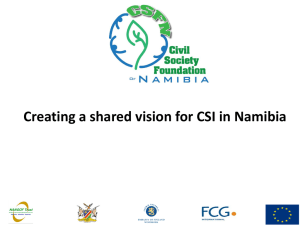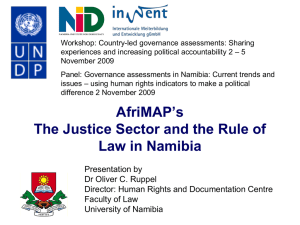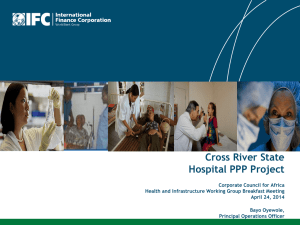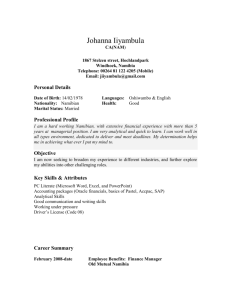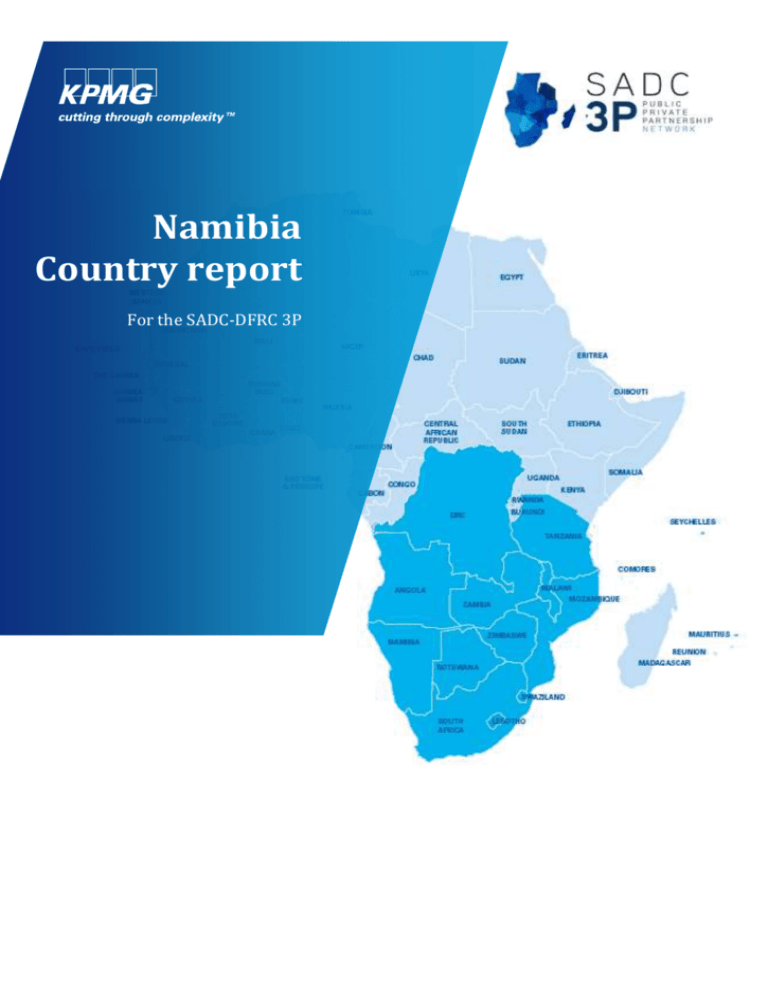
Namibia
Country report
For the SADC-DFRC 3P
Contents
1
Overall evaluation of Namibia’s readiness for PPPs
1
1.1
Background
1
1.2
Attractiveness of Namibia
1
1.3
Availability of domestic capital and debt funding
2
1.4
Judicial system
3
1.5
Governance and decision making
3
1.6
Ease of doing business in the member country
4
1.7
PPP environment in Namibia
4
1.8
Observations
5
1.9
Conclusion
6
Namibia
1
Overall evaluation of Namibia’s
readiness for PPPs
1.1
Background
We evaluated the Member Country by looking at 6 broad categories, containing a number of subcategories. The six (‘6’) broad categories include:
■
■
■
■
■
■
Attractiveness of the member countries
Availability of domestic capital and debt funding
Judicial system
Governance and decision making
Ease of doing business in the member country
PPP environment in the member country
The information and indicators were obtained from external sources like World Bank, World Economic
Forum, IFC, Ibrahim Index of African Governance, KPMG country reports and actual visits to the member
countries (with exception to three (‘3’) countries, namely , Democratic Republic of Congo, Swaziland and
Seychelles). Where possible, KPMG utilised its in-country office to address the categories and answer
questions surrounding the projects.
On the country visits we meet with the member country’s Treasury/PPP unit, one or two banks and
KPMG local office representatives.
Each sub-category was rated either one (‘1’), two (‘2’), three (‘3’) or four (‘4’) based on the indicators
from various reputable sources. Where one (‘1’) and two (‘2’) refers to “Developing towards PPP
readiness” and three (‘3’) and four (‘4’) indicates a “Maturing level of PPP readiness”. Where no
information was available, no value was given. Where there was an element of subjectivity, KPMG, based
on years of experience, applied its own mind in coming up with a value. The overall broad category value
is addressed in more detail below.
1.2
Attractiveness of Namibia
Attractiveness of the member country
Source of information
Information
GDP % growth for last 3 years
World Bank
4.80%
Actual GDP in numbers (size of economy),
current USD$
World Bank
12 510 721 241
Lending Interest rates
World Bank
8.70%
Inflation rate
www.trading
economics.com/countrylist/inflation-rate
6.11%
Credit Rating
Country visit
Not available
Political Stable and Absence of Violence
Governance indicator, World bank
75.9 out of 100
1
Namibia
Macro-Economic Environment
The
Global
Competitiveness
Report
2012-2013,
World
Economic Forum
4.5 out of 7
Attractiveness of Namibia, overall result is a three (‘3’)
Namibia is a financially stable economy with good GDP growth (4.80%) and moderate inflation (6.11%).
It is considered politically stable (75.9/100) and it rate 4.5 out of 7 for macroeconomic stability. This
analysis results in an overall value of three (‘3’), Namibia is thus considered “maturing” in terms of this
category.
1.3
Availability of domestic capital and debt funding
Availability of domestic capital and debt
funding
Source of information
Information
Number of banks
Country visit
4
Number of equity investment funds
Country visit
8 to 10 identified
Number of pension funds
Country visit
Many – 3 public, plus mining
houses and others
3 year history of bond issuance
Country visit
Yes – two bond issues: 2011
Eurobond, 500 million US.
2012 RSA bond, 850 million
ZAR.
Assessment of available capital (local) for
investment
Country visit
There is availability of
capital, but it is considered
illiquid. The requirement for
local investment in equity
funds has however been
increased to 5%, which
while low will have a
positive impact.
Availability of domestic capital and debt funding in Namibia, overall result is a three (‘3’)
Namibia has many potential sources of funding (4 banks and over 8 equity funds) as well as an access to
international funding (3 year history of bond issues). However, the lack of mature secondary markets for
capital means that markets are illiquid. These criteria result in an overall value of three (‘3’), resulting in
an assessment of “maturing” in terms of this category.
2
Namibia
1.4
Judicial system
Judicial system that contributes to effective
commercial dispute resolution
Source of information
Information
Enforcing Contracts
Doing Business 2013 – The
World Bank and IFC
41 out of 183 countries
Rule of Law
Governance indicator, World
bank
61 out of 100
We used the key indicators ‘Enforcing Contracts’ and Rule of Law from Doing Business and World Bank
respectively, as they focuses on how public institutions function in the case of a commercial dispute 1.
Doing Business measures the time, cost and procedural complexity of resolving a commercial lawsuit.
Judicial system of Namibia, overall result is a three (‘3’)
The judicial system serves Namibia well, and it scores highly on enforcement of contracts (41/185) and
rule of law (61/100), resulting in an overall value of three (‘3’) and considered “maturing” in this
category.
1.5
Governance and decision making
Governance and decision making in member
country
Source of information
Information
Institutions
The Global Competitiveness
Report
2012-2013,
World
Economic Forum
4.19 out of 7
Africa’s Governance
Ibrahim Index
Governance
70 out of 100
Voice and accountability
Governance indicator
56.8 out of 100
Government effectiveness
Governance indicator
57.8 out of 100
Regulatory Quality
Governance indicator
55 out of 100
Control of Corruption
Governance indicator
64 out of 100
of
African
Governance and decision making of Namibia, overall result is a two (‘2’)
Namibia has good scores in terms of some governance measures, Institutions (4.19/7) are strong and
Governance (70/100) is highly regarded. Low scores for Voice and accountability (56.8/100),
Government effectiveness (57.8/100) and Regulatory Quality (55/100), however, bring the overall rating
down to a two (‘2’), resulting in an assessment of “developing” in this category.
1
Doing Business 2013, the World Bank and IFC
3
Namibia
1.6
Ease of doing business in the member country
Ease of doing business in the member country
Source of information
Information
Starting a business
Doing Business 2013 – The
World Bank and IFC
133 out of 183 countries
Dealing with Construction permits
Doing Business 2013 – The
World Bank and IFC
56 out of 183 countries
Getting electricity
Doing Business 2013 – The
World Bank and IFC
87 out of 183 countries
Register property
Doing Business 2013 – The
World Bank and IFC
169 out of 183 countries
Getting credit
Doing Business 2013 – The
World Bank and IFC
40 out of 183 countries
Protecting investors
Doing Business 2013 – The
World Bank and IFC
82 out of 183 countries
Paying taxes
Doing Business 2013 – The
World Bank and IFC
112 out of 183 countries
Trading across borders
Doing Business 2013 – The
World Bank and IFC
140 out of 183 countries
Resolving insolvency
Doing Business 2013 – The
World Bank and IFC
59 out of 183 countries
Ease of doing business in Namibia, overall score is a two (‘2’)
Ease of doing business measures are in general medium and higher scores. However, some key “Ease of
Doing Business” measures detract from the overall score. Notably, “Starting a business” (133/185),
“Register property” (169/185), “Paying taxes” (112/185), and “Trading across borders” (140/185) scores
rank Namibia quite low amongst 183 countries listed in the index. These scores bring down the overall
score to a two (‘2’), generating an assessment of “developing” in this category.
1.7
PPP environment in Namibia
Enabling environment in the member country
for PPPs
Source
of
information
Legal system enabling PPPs in the member country
Country visit
-
Is there a presence/development of
enabling legislation ie PPP Law/
regulations etc?
Country visit
-
Does a policy for private participation in
the member country exist?
Country visit
Information
Yes, development of PPP enabling
legislation is in development (mandated
by 2012 cabinet approval). This may take
a long time to be enacted though.
Yes, there is policy for private
participation, this occurs at department
level. However, it is not possible for
Treasury or any government department
to provide financial support or payment
for services within a PPP structure,
additionally, no financial guarantees can
be provided.
4
Namibia
-
Public Sector appetite/capacity and
experience relating to PPPs in the member
country
Is there Political support for PPPs?
Country visit
Country visit
-
Is there a PPP focal point/ Unit in the
member country?
Country visit
-
Does an existing PPP track record in the
member country exist?
Country visit
Private sector capacity, capability and appetite
Yes, there is appetite for PPP
implementation, but there is very limited
experience and capacity in the absence of
a PPP unit. There is also limited
apportunity given the level of support
government can provide as per policy
(above)
Yes, there is political support for PPPs as
given by the approval to develop PPP
legislation and a PPP unit. However, until
progress has been on these two initiatives
it will be difficult to gauge the level
commitment.
Yes, the Permanent Secretary of MOF,
however PPP unit organisation and
structure still in development (
contracted/in procurement with
advisors).
Yes, however the only PPPs we can
identify have been in the Tourism sector
and have required no government
financial support.
Country visit
-
Are multiple firms active in the PPP
market?
Country visit
No, there is limited private participation
by the private sector.
-
Does capacity exist in the private sector?
Country visit
No, there is concern that access to work
permits and skills shortages may limit
capacity, and the fact that many firms are
local subsidiaries of foreign firms
suggests otherwise.
PPP environment in the Namibia, overall score is a two (‘2’)
KPMG, based on years of experience, applied its own mind in coming up with a value.
The PPP environment in Namibia has improved with increased government commitment to PPPs in the
form of the establishment of a PPP unit and the commitment to the development of PPP enabling
legislation. In the absence of such legislation, the environment is very limited. Specifically, government
financial support in the form of unitary payments, support payments and financial guarantees is
prohibited. In addition, private sector capacity is limited without special dispensations regarding the
import of skills and foreign capacity, or reforms of visa and work permit regulations. These criteria result
in an overall score of two (‘2’) or an assessment of “developing”.
1.8
Observations
Our results are based on the most recent verifiable information available at time of the report. Reputable
external sources were used where appropriate and fact based observations have been made.
The Government of Namibia has approved the development of a PPP unit and is currently in beginning
procurement of consulting services for its establishment. There is an indication that PPP enabling
legislation is being drafted, but currently nothing has been enacted. Indications are that there is very
limited PPP procurement occurring within government and that many of these may in fact be more in line
with service contracts rather than benefits/objectives based procurement with any significant transfer of
risk to the private sector.
5
Namibia
PPP representative from Namibia were aware of the projects included in the SADC RIDMP and STAP
programmes, but were not aware of their status and progress. It is understood that current arrangements
are temporary until an official PPP unit is established. In addition, much project information is available
at a departmental level, and was thus inaccessible on short notice.
Indications are that many key projects lag in development and execution due to disagreement between
stakeholders, including implementing departments and state-owned entities, supply and off-take entities.
Finally, it was acknowledged that the current regulatory regime was a significant impediment to the
creation of an active market for PPPs and progress on legislation crucial to further development of PPPs.
1.9
Conclusion
In conclusion, the above analysis would suggest that only PPPs with firm private sector revenues or
agreed feed-in tariffs, with no need for significant government support, will be successfully implemented.
Other PPPs without these characteristics could be developed in anticipation of legislative reform, but this
would be with some risk at this phase of PPP readiness maturity. Moreover, PPPs that require significant
technical skills in operation, maintenance and management may meet difficulties in implementation.
Finally, complexities relating to business start-up, property registration, taxation and cross border
activities mean that rigorous due diligence activities and methodical project planning will be key to PPP
project success.
PPPs could be implemented in Namibia in the current environment as the other broad categories indicate
that this would be possible. It is not an impending need to have enacted legislation, although this will
assist. Overall Namibia is thus considered “maturing” in terms of this assessment.
6
© 2013 KPMG Services (Pty) Ltd, a South African company and a member firm of the KPMG
network of independent member firms affiliated with KPMG International Cooperative (“KPMG
International”), a Swiss entity. All rights reserved.
The information contained herein is of a general nature and is not intended to address the
circumstances of any particular individual or entity. Although we endeavour to provide
accurate and timely information, there can be no guarantee that such information is accurate as
of the date it is received or that it will continue to be accurate in the future. No one should act
on such information without appropriate professional advice after a thorough examination of
the particular situation.
The KPMG name, logo and “cutting through complexity” are registered trademarks or
trademarks of KPMG International.

